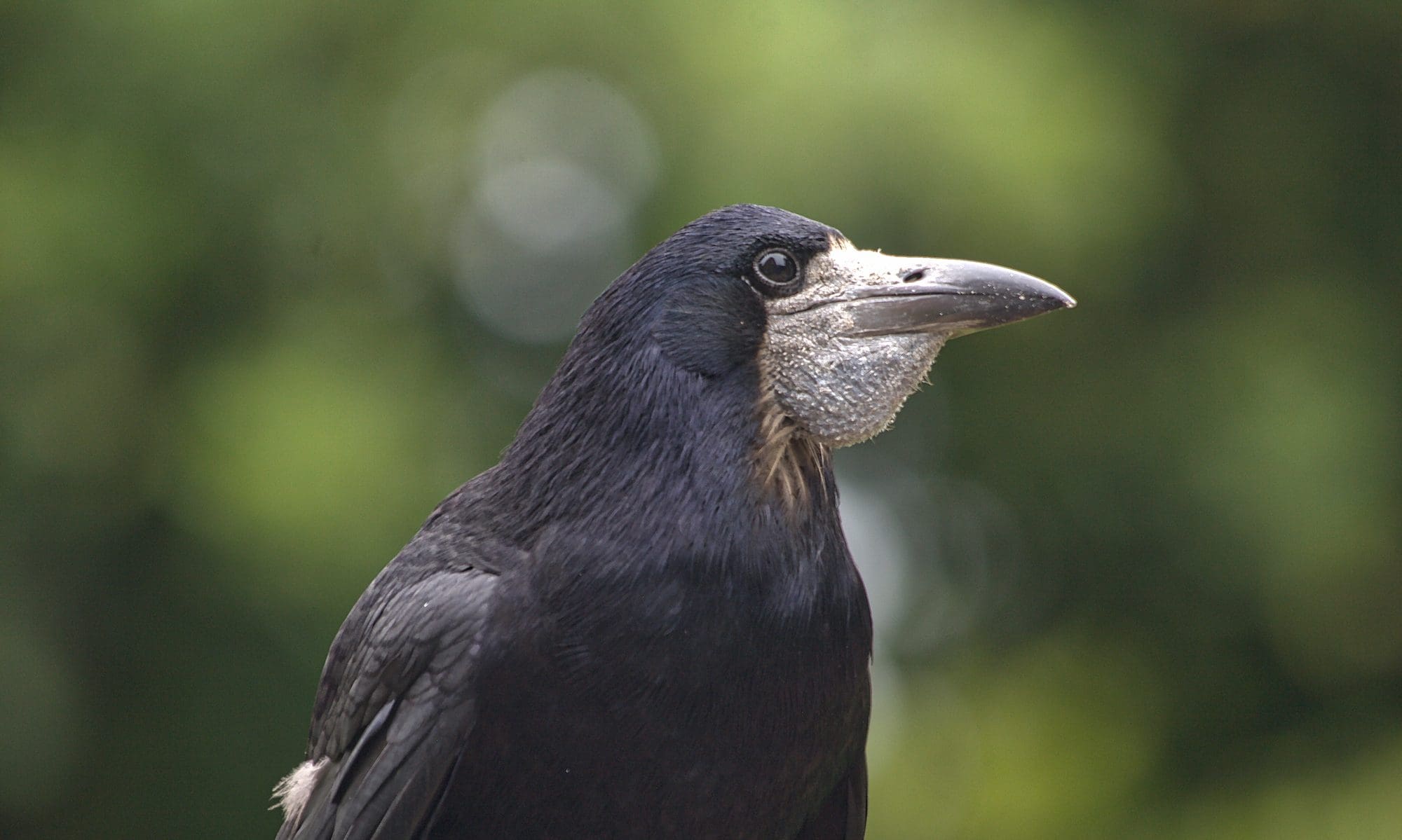
It is usually not difficult to differentiate between adult rooks (Corvus frugilegus) and carrion crows (Corvus corone). Both species may look similar at the first glance, because both have black feathers that can also look glossy. However, the long pale and pointy beak, with bare skin around its base, is the most striking and characteristic feature of rooks. It is also worth knowing that rooks nest collectively in tall trees, often close to farms or villages, which are known as rookeries. In contrast, carrion crows are fairly solitary and are usually found alone or in pairs, although they may form occasional non-breeding flocks. Unlike rooks, carrion crows do nest solitary, maintaining a large breeding territory centred around the nest.

Additional help and information about how to identify adult corvids including rooks and carrion crows can be found on the British Trust for Ornithology website (BTO).
British Trust for Ornithology (BTO) – Identifying Corvids – Crow, Chough, Jackdaw, Rook and Raven
Identification of Juvenile Rooks and Carrion Crows
During their first year, juvenile carrion crows and rooks look very similar and their identification can be difficult. The main cause of confusion is that rooks do not develop the bare whitish bill-base or face until their second calendar year. This means that for this age group distinguishing visually between juveniles of these two species relies mainly on the correct judgement of proportions and shape.
The Easy Way
An easy and usually reliable way of distinguishing the two species in their fledgling state is to do a thorough background assessment of the bird admitted into human care, as one would do for any admission. Corvid fledglings are often found near the nesting site, which means that a corvid fledgling found in close proximity of a rookery is most likely a rook, as crows will not nest in the same area. Similarly, a corvid fledgling found near a known crow nest is likely to be a carrion crow. It is also advisable to observe adult birds in the vicinity of the location where the bird in question has been found, as this might provide helpful clues. Unfortunately, the above mentioned assessment may not always be possible or correct, in particular not when birds become older and more mobile. In these cases other features have to be taken in account for the identification of juvenile rooks and carrion crows.
The Usual Way
Juvenile carrion crows can be identified by their brownish, sometimes slightly dull plumage and blueish eyes, both of which darken to black and brown as the crow grows older. However, the eyes of young rooks are also blue, but not as bright blue and perhaps rather a little more greyish. The juvenile rook plumage is black with a slight greenish gloss, except for the hind neck, back and underparts, which are brownish-black too. The feathered thighs of rooks can also be a helpful clue, although this characteristic is more easily ascertained by direct comparison between the two species, and may also take some time to develop. In contrast, juvenile carrion crows have rather bare thighs. Rooks often show slightly ruffled drooping belly feathers, whereas carrion crows demonstrate a rather neat belly feather arrangement.
Rook Gallery
The feathers at the base of the beak of rooks look rougher, whilst those of carrion crows have often a more neat appearance. Rooks occasionally, but not always, have a small white patch involving the throat area underneath the lower bill between the rami of the mandible. However, occasionally crows may show a similar feature, in particular those with deficient plumage. The tail of rooks is usually notably more spatulate and rounded compared to the carrion crow tail. The wings of a carrion crow are proportionally shorter and broader than those of the rook, in particular when seen in flight.
Carrion Crow Gallery
The forehead of rooks appears to be steeper, compared to crows, sometimes almost vertical, its crown more peaked and the overall body appearance might be perceived as scrawny. Rook bills are usually less bulky, straighter, more slender and pointy. Carrion crow bills are slightly shorter, more sturdy and slightly curved. Those features apply in particular to the upper bill. The upper carrion crow bill might have already or tends to develop a tiny terminal hook, whilst rook bills usually do not show this feature. The base of the otherwise black rook beak is often slightly yellow-ish, which is not so commonly seen in carrion crows.
Rook and Carrion Crow Vocalisations
Last but not least, and not unexpected, vocalisations of rooks and carrion crow fledglings begging for food are different too, which can be useful knowledge when trying to distinguish both species.
The Importance of Species Identification
Species identification is an important aspect for the rescue and rehabilitation of wild animals in general, as there are obviously species dependent differences when it eventually comes to the release of these animals in human care. Rooks and carrion crows are no exception to this rule. Even when taking all the above outlined features in consideration, there is a considerable variation to expect, which leaves species identification a challenging task, in particular for juveniles of these two species. To assist the identification process, we have created a photo collection of the day by day development of our carrion crow Amor, which might be useful for identification purposes and similarly for the establishment of the age of a rescue bird.
Carrion Crow Amor – A Day By Day Photo Collection
More information about care, rehabilitation and release of corvids in general can be found by following the links below.
When Can I Release My Rescued Corvid Fledgling?



Very interesting as always! With hooded crows we don’t have this issue, but it is still nice to learn about the differences. Thank you for helping birds and educating people! 🖤
Thank you very much.